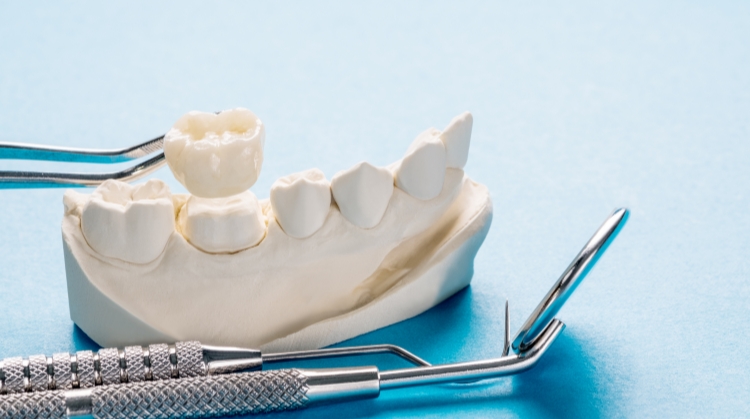Implant Bridge: A Comprehensive Solution for Missing Teeth
Tooth loss can affect not just your smile but also your ability to speak, chew, and feel confident in social situations. If you’re missing multiple teeth, you may have already explored dentures or traditional bridges. However, there’s a more durable, modern option worth considering: the implant bridge.
An implant bridge is a permanent solution that combines the stability of dental implants with the convenience of a bridge, offering unmatched function and aesthetics. In this guide, we’ll walk you through what an implant bridge is, how it works, and why it might be the best solution for restoring your smile.
What Is an Implant Bridge and How Does It Work?
An implant bridge is a dental restoration used to replace two or more missing teeth in a row. Rather than relying on your existing teeth for support like a traditional bridge, an implant bridge is anchored directly into the jaw using titanium dental implants. These implants act like artificial roots, creating a sturdy foundation for your new teeth.
Here’s how it typically works: two or more dental implants are placed into the jawbone at either end of the missing tooth area. After healing, a custom-made bridge is securely attached to these implants. The result? A seamless, stable set of artificial teeth that look and feel like your natural ones.
This method is particularly effective when several adjacent teeth are missing, and the surrounding teeth are not strong enough—or shouldn’t be compromised—to support a traditional bridge. By using implants, we avoid the need to file down healthy neighboring teeth, which is required for conventional bridges.
Benefits of Choosing an Implant Bridge Over Traditional Options
There are numerous reasons why an implant bridge stands out as a preferred solution for many patients.
First and foremost, implant bridges are far more stable than traditional removable dentures or standard bridges. They don’t slip or shift in the mouth, meaning you can speak and eat with confidence. Unlike dentures, there’s no need to use adhesives or remove them at night.
Another critical advantage is bone preservation. When you lose teeth, the jawbone beneath them begins to shrink due to lack of stimulation. Dental implants provide the stimulation that your jaw needs to maintain its density and structure. This prevents the sunken facial appearance that can occur with tooth loss over time.
Durability is also a key benefit. With proper care, implant bridges can last 15 to 25 years or more, whereas traditional bridges typically need replacement every 5 to 10 years.
Aesthetically, implant bridges are designed to blend naturally with your existing teeth. Skilled dentists and lab technicians craft them to match the color, shape, and size of your original teeth, restoring your smile to its natural beauty.
Perhaps most importantly, implant bridges help protect your remaining natural teeth. Traditional bridges require grinding down adjacent teeth to support the prosthesis, which can weaken them. Implant bridges eliminate this need entirely, preserving the long-term health of your mouth.
The Step-by-Step Process of Getting an Implant Bridge
Getting an implant bridge isn’t a same-day procedure—it’s a carefully planned, multi-step process that ensures lasting success and patient safety. Here’s what you can typically expect:
1. Initial Consultation and Diagnostic Imaging
Your journey starts with a comprehensive dental evaluation. This includes X-rays, 3D scans, and sometimes digital impressions. Your dentist will assess your overall oral health, bone density, and gum condition to determine whether you’re a good candidate for dental implants.
2. Implant Placement
If you’re eligible, the next step is implant placement. This minor surgical procedure involves placing titanium posts into the jawbone where the missing teeth once were. Local anesthesia or sedation is used to ensure comfort.
3. Healing and Osseointegration
Over the next three to six months, your implants undergo a process called osseointegration, where the jawbone fuses with the titanium posts. This creates a strong, stable foundation for your bridge. In the meantime, you may wear a temporary bridge or denture.
4. Abutment Attachment
Once the implants are fully integrated, small connectors known as abutments are attached. These serve as the link between your implants and the final bridge.
5. Bridge Placement
Finally, your custom-designed bridge is secured to the abutments. Your dentist will ensure a perfect fit and make any necessary adjustments to your bite. You’ll leave with a fully functional, beautiful smile
Are You a Candidate for an Implant Bridge?
Most healthy adults missing multiple adjacent teeth are potential candidates for an implant bridge, but a few key factors must be considered.
The first requirement is adequate jawbone volume. Since implants are placed into the bone, there needs to be enough bone structure to support them. If bone loss has occurred, a bone grafting procedure may be needed beforehand.
Your overall health is also important. Chronic conditions like uncontrolled diabetes, autoimmune disorders, or a history of radiation therapy in the head or neck area may affect healing and increase the risk of complications.
Gum health and oral hygiene habits also play a role. Healthy gums are essential for successful implant integration, and patients must be committed to maintaining good oral hygiene to avoid complications like peri-implantitis.
Finally, smoking can interfere with healing and reduce implant success rates. If you smoke, your dentist may recommend quitting before moving forward with treatment.
The best way to find out if you’re a good candidate is through a professional consultation with a dental implant specialist.
Conclusion
An implant bridge is a cutting-edge dental solution designed to restore function, beauty, and confidence to those missing multiple teeth. With its stable fit, bone-preserving benefits, and natural appearance, it offers a long-term solution that outperforms traditional bridges and dentures in many ways.
Whether you’re struggling with a partial denture or looking to replace a failing bridge, it may be time to explore how an implant bridge can transform your oral health and overall well-being.
Ready to restore your smile with a secure and lasting solution?
Book a personalized consultation today and discover how an implant bridge can help you eat, speak, and smile with confidence again.
FAQ
1. What is the difference between an implant bridge and a dental implant?
A dental implant usually replaces a single tooth. An implant bridge replaces multiple teeth using fewer implants as anchors, making it more cost-effective and efficient for larger gaps.
2. How long does an implant bridge last?
With regular care and dental visits, implant bridges can last 15–25 years, or even longer. Their longevity depends on your oral hygiene habits and overall health.
3. Is getting an implant bridge painful?
The procedure is done under local anesthesia, so you won’t feel pain during surgery. Some discomfort is normal during healing, but it’s usually manageable with over-the-counter medication.
4. How much does an implant bridge cost?
Prices vary based on the number of implants and the materials used, but on average, an implant bridge costs between $4,000 and $15,000. Many dental offices offer financing or payment plans.
5. Can I eat normally with an implant bridge?
Yes! Once healed, you can enjoy your favorite foods without worry. Implant bridges are strong, stable, and function like your natural teeth.




